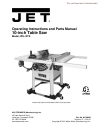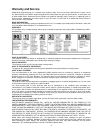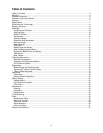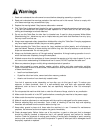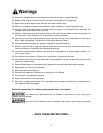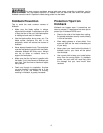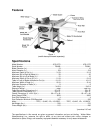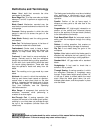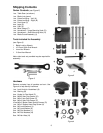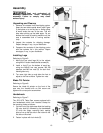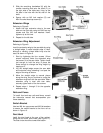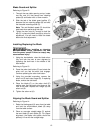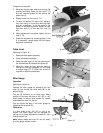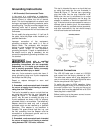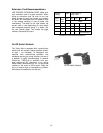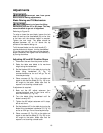
8
Definitions and Terminology
Arbor: Metal shaft that connects the drive
mechanism to the blade.
Bevel Edge Cut: Tilt of the saw arbor and blade
between 0° and 45° to perform an angled cutting
operation.
Blade Guard: Mechanism mounted over the
saw blade to prevent accidental contact with the
cutting edge.
Crosscut: Sawing operation in which the miter
gauge is used to cut across the grain of the
workpiece.
Dado Blade: Blade(s) used for cutting grooves
and rabbets.
Dado Cut: Flat bottomed groove in the face of
the workpiece made with a dado blade.
Featherboard: Device used to keep a board
against the rip fence or table that allows the
operator to keep hands away from the saw
blade.
Freehand: If used hand to move workpiece is
danger. Devices used to feed the workpiece
though the saw blade during cutting operations.
A push stick (not a push block) should be used
for narrow ripping operations. These aids help
keep the operator’s hands well away from the
blade.
Kerf: The resulting cut or gap made by a saw
blade.
Kickback: An event in which the workpiece is
lifted up and thrown back toward an operator,
caused when a work piece binds on the saw
blade or between the saw blade and rip fence
(or other fixed object). To minimize or prevent
injury from kickbacks, see the Operating
Instructions section.
Miter Gauge: A component that controls the
workpiece movement while performing a
crosscut of various angles.
Non-Through Cut: A sawing operation that
requires the removal of the blade guard splitter,
resulting in a cut that does not protrude through
the top of the workpiece (includes Dado and
rabbet cuts).
The blade guard and splitter must be re-installed
after performing a non-through cut to avoid
accidental contact with the saw blade during
operation.
Parallel: Position of the rip fence equal in
distance at every point to the side face of the
saw blade.
Perpendicular: 90° (right angle) intersection or
position of the vertical and horizontal planes
such as the position of the saw blade (vertical)
to the table surface (horizontal).
Push Board/Push Stick: An instrument used to
safely push the workpiece through the cutting
operation.
Rabbet: A cutting operation that creates an
L-shaped channel along the edge of the board.
Rip Cut: A cut made along the grain of the
workpiece.
Splitter: Metal plate to which the blade guard is
attached that maintains the kerf opening in the
workpiece when performing a cutting operation.
Standard Kerf: 1/8" gap made with a standard
blade.
Straightedge: A tool used to check that a
surface is flat or parallel.
Through Sawing: A sawing operation in which
the workpiece thickness is completely sawn
through. Proper blade height usually allows 1/8"
of the top of blade to extend above the wood
stock. Keep the blade guard down, the anti-
kickback pawls down, and the spreader in place
over the blade.
Read and understand the entire contents of this manual before attempting
assembly or operation! Failure to comply may cause serious injury!



